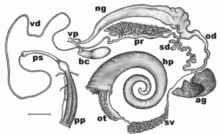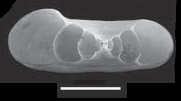Biomphalaria tenagophila
| Biomphalaria tenagophila | |
|---|---|
 | |
| Apical, apertural and umbilical views of the shell of Biomphalaria tenagophila. Scale bar is 3 mm. | |
| Scientific classification | |
| Kingdom: | Animalia |
| Phylum: | Mollusca |
| Class: | Gastropoda |
| (unranked): | clade Heterobranchia clade Euthyneura clade Panpulmonata clade Hygrophila |
| Superfamily: | Planorboidea |
| Family: | Planorbidae |
| Subfamily: | Planorbinae |
| Tribe: | Biomphalariini |
| Genus: | Biomphalaria |
| Species: | B. tenagophila |
| Binomial name | |
| Biomphalaria tenagophila (Orbigny, 1835)[1] | |
| Synonyms | |
Biomphalaria tenagophila is a species of air-breathing freshwater snail, an aquatic pulmonate gastropod mollusk in the family Planorbidae, the ram's horn snails.
This species is medically important pest,[3] because of transferring the disease intestinal schistosomiasis. (Intestinal schistosomiasis is the most widespread of all types of schistosomiasis).
The parasite Schistosoma mansoni, which Biomphalaria snails carry, infects about 83.31 million people worldwide.[4]
The shell of this species, like all planorbids is sinistral in coiling, but is carried upside down and thus appears to be dextral.
Taxonomy
Biomphalaria tenagophila was originally discovered and described under the name Planorbis tenagophilus by the French naturalist Alcide d'Orbigny in 1835.[1] Orbigny (1835) referred its distribution to Corrientes Province, Argentina and to Santa Cruz Department, Bolivia (referred as "Santa-Cruz et Chiquitos"). But Orbigny himself later limited its distribution to Ensenada, Buenos Aires Province, Argentina in 1837.[5]
Subspecies recognized in this species include:
- Biomphalaria tenagophila tenagophila (d’Orbigny, 1835)
- Biomphalaria tenagophila guaibensis Paraense, 1984[5] - Biomphalaria tenagophila guaibensis can be distinguished from the nominal subspecies according to the details on the reproductive system only.[5]
There are also three "old-style" proposals of subspecies, based on shell characteristics:[5]
- Planorbis tenagophilus chemnitziana Beck, 1837 - this name is based on the catalog for the shell in Museum of Copenhagen, but without description.[5]
- Planorbis tenagophilus orbignyana Beck, 1837 - the same situation as in P. t. chemnitziana[5]
- Australorbis bahiensis megas Pilsbry, 1951[6]
History of discoveries summarized Paraense (2001).[7]
Phylogeny
A cladogram showing phylogenic relations of species in the genus Biomphalaria:[8]
| Biomphalaria |
| ||||||||||||||||||||||||||||||||||||||||||||||||||||||||||||||||||||||||||||||||||||||||||||||||||||||||||||||||||||||||||||||||||||||||||||||||
| |
Distribution
Biomphalaria tenagophila is a Neotropical[3] species and its native distribution include Peru,[9] Brazil, Uruguay[5] and Argentina.
This species has recently expanded its native range.[3][10]
The non-indigenous distribution of Biomphalaria tenagophila includes a hypothermal spring near Răbăgani, Romania (46°45´1.3´´N, 22°12´44.8´´E).[10]
Shell description
The shell is sinistrally coiled (has left-handed coiling). The flat shells are yellow-brown, discoidal, deeply and symmetrically biconcave, and consist of 5 or 6 slowly increasing whorls. The last whorl is rounded; the intermediate whorls are slightly angled on the left side. The aperture is circular or slightly ovate and angled toward the left side of the shell (i.e., toward the upper surface on the bottom right shell). Fine, parallel, rib-like transverse lines can be seen on the outer surface of the whorls.[10]
The width of the shell is usually from 11 to 13 mm,[10] but in the largest individuals, the shell can reach 21 mm in width, 6.5 mm in height and have 6.5 whorls.[5]
 A shell of Biomphalaria tenagophila. |

ag - albumin gland
bc - bursa copulatrix
hp - distal part of the hepatopancreas
ng - nidamental gland
od - oviduct
ot - ovotestis
pp - preputium
pr - prostate
ps - penis sheath
sd - spermiduct
sv - seminal vesicles
vd - vas deferens
vp - vaginal pouch.
Anatomy
The anatomy of this species was firstly published under the synonym Australorbis nigricans in 1955.[11]
The body length varies from 56 mm to 64 mm.[11]
The radula has from 125 to 168 rows of denticles (tiny teeth). The number of lateral teeth varying from 28 to 36. The mode radula formula is 31-0-31.[11]
The specific characteristics of the reproductive system of Biomphalaria tenagophila are: more than 200 diverticulae of the ovotestis; 7–11 main lobes of the prostate; and presence of vaginal pouch.[10]
Ecology
Habitat of Biomphalaria tenagophila is tropical standing water or freshwater.[10]
Biomphalaria tenagophila is an intermediate host for Schistosoma mansoni and a vector of schistosomiasis.[12] Schistosoma mansoni came to Neotropics from Africa in context of the slave trade.[8] Schistosoma mansoni was not able to infect Biomphalaria tenagophila in 1916 and it has adapted to this host since 1916.[8]
Experimental parasites include:
- Angiostrongylus vasorum - (experimental)[13]
References
This article incorporates public domain text from the reference.[10]
- 1 2
 d’Orbigny A. (1835) Synopsis terrestrium et fluviatilium molluscoum, in suo per Americam meridionalem itinere collectorum. Magasin de zoologie 5(62): 1-44. Page 26.
d’Orbigny A. (1835) Synopsis terrestrium et fluviatilium molluscoum, in suo per Americam meridionalem itinere collectorum. Magasin de zoologie 5(62): 1-44. Page 26. - ↑
 Spix J. B. & Wagner J. A. (1827) Testacea Fluviatilia Brasiliensis. vi. + 36 pp., 29 tab., typ. C, Wolf, Monachii.
Spix J. B. & Wagner J. A. (1827) Testacea Fluviatilia Brasiliensis. vi. + 36 pp., 29 tab., typ. C, Wolf, Monachii. - 1 2 3 Pointier, J. P.; Pointier, J. P.; David, P.; Jarne, P. (2005). "Biological invasions: The case of planorbid snails". Journal of Helminthology. 79 (3): 249–256. doi:10.1079/JOH2005292. PMID 16153319.
- ↑ Crompton, D. W. (1999). "How much human helminthiasis is there in the world?" (PDF). The Journal of Parasitology. 85 (3): 397–403. doi:10.2307/3285768. JSTOR 3285768. PMID 10386428.
- 1 2 3 4 5 6 7 8 Paraense, W. L. (1984). "Biomphalaria Tenagophila Guaibensis ssp. N. From Southern Brazil and Uruguay (pulmonata: Planorbidae). I. Morphology". Memórias do Instituto Oswaldo Cruz. 79 (4): 465–469. doi:10.1590/S0074-02761984000400012.
- ↑ Pilsbry, H. A. (1951). "Notes on some Brazilian Planorbidae". Nautilus. 65 (1): 3–6.
- ↑ Paraense W. L. (2001) "The Schistosome Vectors in the Americas". Memórias do Instituto Oswaldo Cruz 96(Supplement): 7-16. text Archived July 6, 2011, at the Wayback Machine., PDF Archived July 6, 2011, at the Wayback Machine.
- 1 2 3 Dejong, R. J.; Morgan, J. A.; Paraense, W. L.; Pointier, J. P.; Amarista, M.; Ayeh-Kumi, P. F.; Babiker, A.; Barbosa, C. S.; Brémond, P.; Pedro Canese, A.; De Souza, C. P.; Dominguez, C.; File, S.; Gutierrez, A.; Incani, R. N.; Kawano, T.; Kazibwe, F.; Kpikpi, J.; Lwambo, N. J.; Mimpfoundi, R.; Njiokou, F.; Noël Poda, J.; Sene, M.; Velásquez, L. E.; Yong, M.; Adema, C. M.; Hofkin, B. V.; Mkoji, G. M.; Loker, E. S. (2001). "Evolutionary relationships and biogeography of Biomphalaria (Gastropoda: Planorbidae) with implications regarding its role as host of the human bloodfluke, Schistosoma mansoni". Molecular Biology and Evolution. 18 (12): 2225–2239. doi:10.1093/oxfordjournals.molbev.a003769. PMID 11719572.
- ↑ Paraense, W. L. (2003). "Planorbidae, Lymnaeidae and Physidae of Peru (Mollusca: Basommatophora)" (PDF). Memórias do Instituto Oswaldo Cruz. 98 (6): 767–771. doi:10.1590/s0074-02762003000600010.
- 1 2 3 4 5 6 7
 Majoros G., Fehér Z., Deli T. & Földvári G. (11 November 2008) "Establishment of Biomphalaria tenagophila snails in Europe". letter, Emerging Infectious Diseases 14(11): 1812-1814. doi:10.3201/eid1411.080479
Majoros G., Fehér Z., Deli T. & Földvári G. (11 November 2008) "Establishment of Biomphalaria tenagophila snails in Europe". letter, Emerging Infectious Diseases 14(11): 1812-1814. doi:10.3201/eid1411.080479 - 1 2 3 Paraense W. L. & Deslandes N. (1955) "Observations on the morphology of Australorbis nigricans". Memórias do Instituto Oswaldo Cruz 53(1): 121-134. abstract.
- ↑ Borda C. E. & Rea M. J. F. (March 2007) "Biomphalaria tenagophila potencial vector of Schistosoma mansoni in the Paraná River basin (Argentina and Paraguay)". Memórias do Instituto Oswaldo Cruz 102(2): 191-195. PDF.
- ↑ Pereira, C. A. J.; Martins-Souza, R. L.; Coelho, P. M. Z.; Lima, W. S.; Negrão-Corrêa, D. (2006). "Effect of Angiostrongylus vasorum infection on Biomphalaria tenagophila susceptibility to Schistosoma mansoni". Acta Tropica. 98 (3): 224–233. doi:10.1016/j.actatropica.2006.05.002.
Further reading
- Barracco, Margherita Anna; Steil, Ana Angélica; Gargioni, Rogério (1993). "Morphological characterization of the hemocytes of the pulmonate snail Biomphalaria tenagophila". Mem. Inst. Oswaldo Cruz. 88 (1): 73–83. doi:10.1590/s0074-02761993000100012.
External links
| Wikimedia Commons has media related to Biomphalaria tenagophila. |
